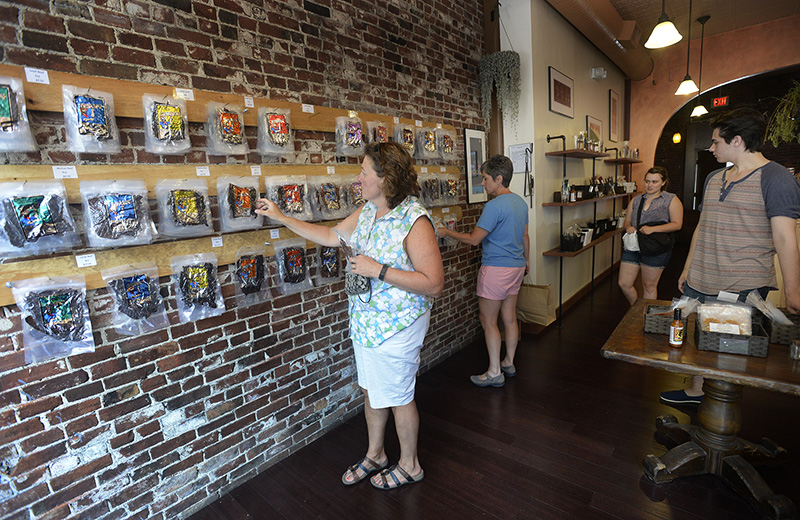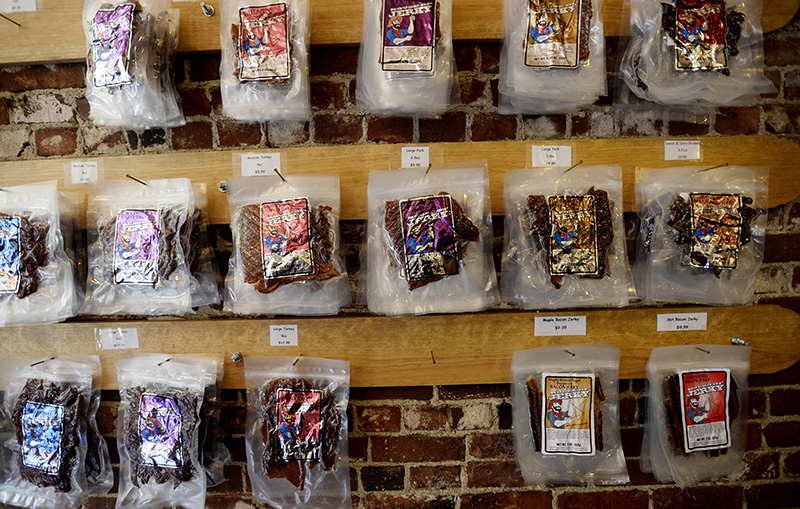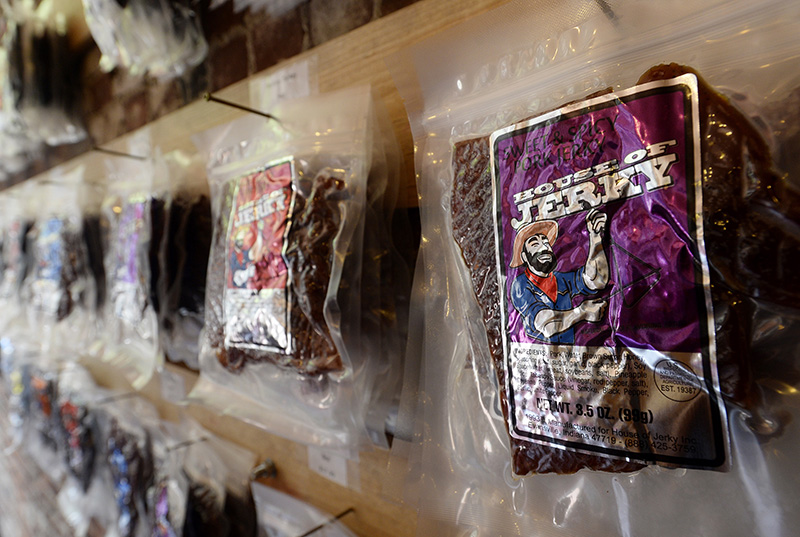Matt DiBenedetto was an executive chef making decent money when he decided he really needed a change.
A big one.
“I quit my job, opened a jerky store and people told me I was out of my mind,” DiBenedetto recalled in a phone interview from his business in North Conway, N.H.
But his North Conway House of Jerky store did so well that, five weeks ago, he and some business partners opened a new shop on Exchange Street called the Old Port House of Jerky.
The store sells all kinds of jerky, from the usual beef to more exotic varieties like kangaroo, ostrich and wild boar. But make no mistake – it’s all jerky.
Old Port House of Jerky wouldn’t be the first store in the city to focus on a single item. The Old Port also has a popcorn store, a cupcake store and a store focused on nothing but salts. Across town, the Honey Exchange on Stevens Avenue sells only honey and all kinds of honey-related items, including bottles of mead and bee umbrellas for kids. It even has a honey tasting bar.
Besides being curiosities, stores like these raise the question of, well, how do they survive – especially when they’re paying Old Port rents? What happens to business in winter, when the steps of T-shirt and flip-flop clad tourists have been silenced by howling winds and the crunch of ice underfoot?
Just last week, business pundits were pondering the closure of Crumbs, the trendy cupcake chain that started in New York but succumbed to the costs that come with rapid expansion and the “diminished uniqueness,” as one expert put it, of a product that customers were growing bored with (“Sex and the City” is soooo 2000) and that smaller bakeries could do better.
Before Crumbs, there was Mrs. Fields, whose cookies have half the storefronts they did a decade ago, and Krispy Kreme Doughnuts, which has always focused its efforts on making one hell of a doughnut, as opposed to its competitors who branch out into sandwiches and other less sugary menu items. Now Krispy Kreme is expanding rapidly again (not unlike many of its customers) after a long roller-coaster ride of contraction and expansion and contraction.
Remember when frozen yogurt was fresh and new in the 1980s? TCBY is still around, but a quarter of the size it was a decade or two ago, thanks to more competition.
Owning a store that focuses on a single food item can be an advantage in some ways, says J.P. Eggers, an assistant professor of management at the New York University Stern School of Business, because you can be close to the customers and in tune with exactly what they want.
“If there’s a real consumer base that really wants that product and cares about specific details and authenticity and things like that, being focused can give you a good way to appeal to those types of customers,” Eggers said. “The real challenge, from a retail perspective especially, is that a huge portion of your costs – typically real estate and labor – are fixed costs. They’re not going to change, no matter how much you sell. Your revenues are very unpredictable if they’re tied to a single product. So for the most part, the things that make those types of stores successful long-term are finding ways to kind of minimize the risk on the revenue side.”
An ice cream store sells a single product, yet we don’t question whether they will make it, although there were skeptical rumblings a few years ago when several ice cream/gelato/froyo stores opened within a couple of blocks of each other in the Old Port. (They’re all still open.) Revenues from ice cream tend to be more predictable.
“Ice cream shops generally are good repeat-business generators,” Rita Gunther McGrath, a professor at Columbia Business School, wrote in an e-mail interview. “In summer, it’s possible for someone to buy ice cream every day. It becomes a habit or ritual. Somehow I don’t see jerky taking on that kind of position in people’s daily lives.”
WHEN THE BUBBLE BURSTS
The problem with trendy foods is that no one really knows what sales will look like five years from now. If a business owner catches the upswing of a trend, Eggers said, they may be able to get several years of good business before having to worry about the bubble bursting. That’s what happened with Crumbs.
“They came in relatively early in the cupcake trend,” Eggers said. “They actually made a lot of money for a period of time, but they got themselves in trouble because they overexpanded.”
DiBenedetto, the co-owner of Old Port House of Jerky, does not consider his business trendy – although there are some current crazes that fit the product nicely. The original House of Jerky, he points out, was started on the streets of California about 20 years ago by a man named Ron Hargett. There are now at least two dozen House of Jerky stores around the country, whose owners get their product from the factories where the jerky is made, in California and Indiana.
This – dare we say it – artisanal jerky taps into trends focused not only on low-carb foods, but on high-quality foods that have been processed as little as possible. It’s popular with weight watchers, athletes and people who are into the (currently white hot) Paleo diet. People throw it into their car or backpack, or tuck it into their child’s school bag for lunch.
“A lot of jerky is made with scrap meat, fillers, msg, high sodium, stuff like that,” DiBenedetto said. “All our products through the House of Jerky are farm-raised, grass-fed, very low sodium, no phosphates. All our beefs are cut from top round, except for the two brisket cuts. So stuff is very clean, very healthy.”
DiBenedetto has tapped into the gluten-free craze, encouraging Hargett to come out with a line of products not marinated in soy sauce, which contains gluten, as jerky often is. For people who don’t like meat, he has four kinds of pineapple jerky – and he’s bringing in some cactus jerky.
The store hedges its bets by offering pickles, salsa and a few other products along with the main attraction, including some from the Portland Fruit & Nut Co. and from Fryeburg-based Pickles-N-Things.
“People say, ‘How can you afford to make a living on that little store?’ ” DiBenedetto said. “If people really knew my numbers over here (in North Conway), they’d be going, ‘When can I open my jerky store?’ ”
Still, Eggers predicts that one of the challenges a jerky store could face is keeping things fresh in the face of changing demands from customers.
“What they don’t always understand very well is how jerky’s doing relative to 500 other product categories because they don’t see those other 499 categories, they just see jerky,” he said.
You might think the closure of Crumbs would make Alysia Zoidis, the owner of East End Cupcakes, a little nervous.
Like a lot of people who own single-item stores, Zoidis started her business because she had a passion – for baking. She moved to Portland from New York, where cupcakes were popular, and realized her new home did not yet have a cupcake store.
Still, Zoidis says, “It’s not the trend that I’m banking on, it’s the appeal of cupcakes themselves.”
She views cupcakes as a blank canvas for different flavors and flavor combinations. To supplement her storefront cupcake sales, Zoidis does a lot of weddings.
Yes, brides are some of the most fickle consumers around, following trends like a pig sniffs out truffles. But cupcakes tend to be less expensive than a big wedding cake, there are no cake cutting fees, and there are more flavors to offer guests.
But the store’s positioning as a local business that offers something unique for tourists is probably one of the biggest factors working to her benefit.
If a specialty store sells to transient customers, “there is much less risk of single-item fatigue setting in, because the population changes continually,” McGrath said.
Being part of a chain can diminish a store’s appeal if it’s located in a tourist district, Eggers said.
“If I feel like a high-end cupcake shop in Portland, Maine, is the exact same shop that existed back where I was from in Indiana or wherever, I’m not going to want to go buy them there because I can get them back home,” he said.
Well, there is another alternative. DiBenedetto and Zoidis could put their heads together and create a jerky cupcake.
Send questions/comments to the editors.









Comments are no longer available on this story